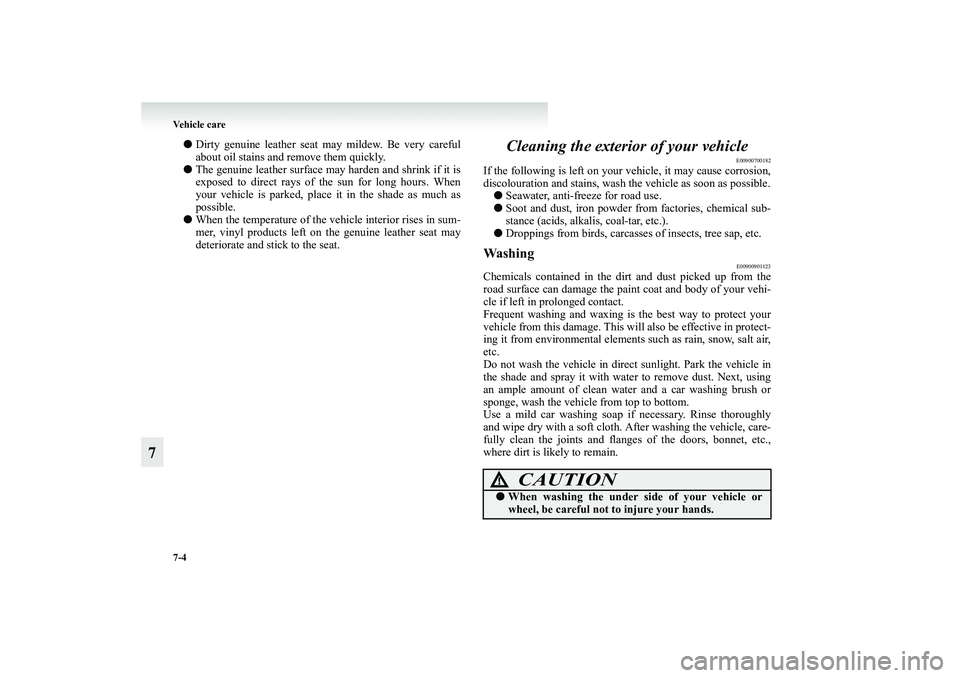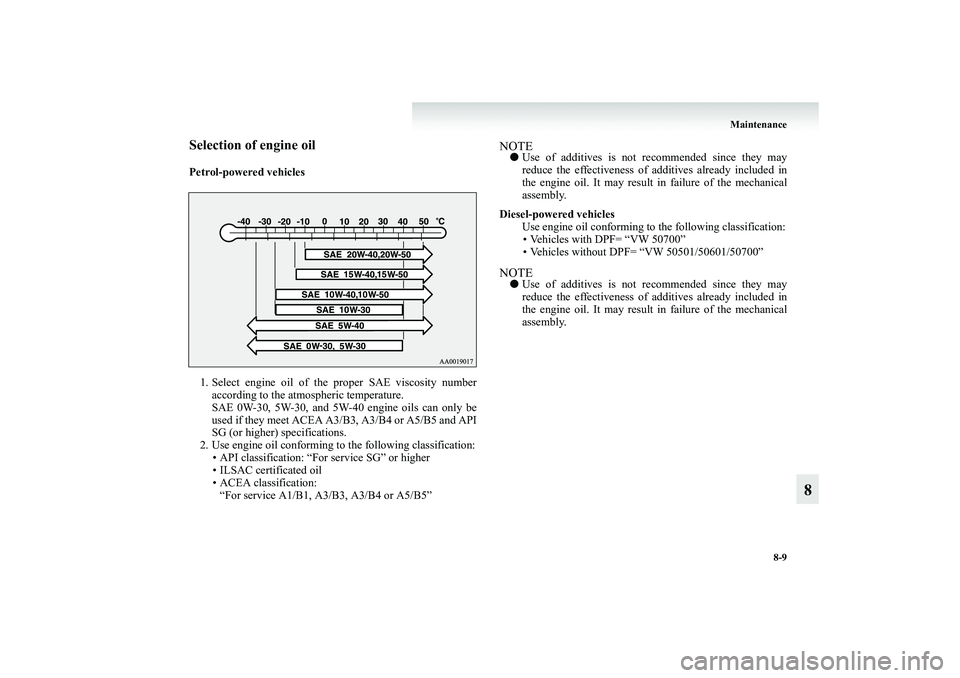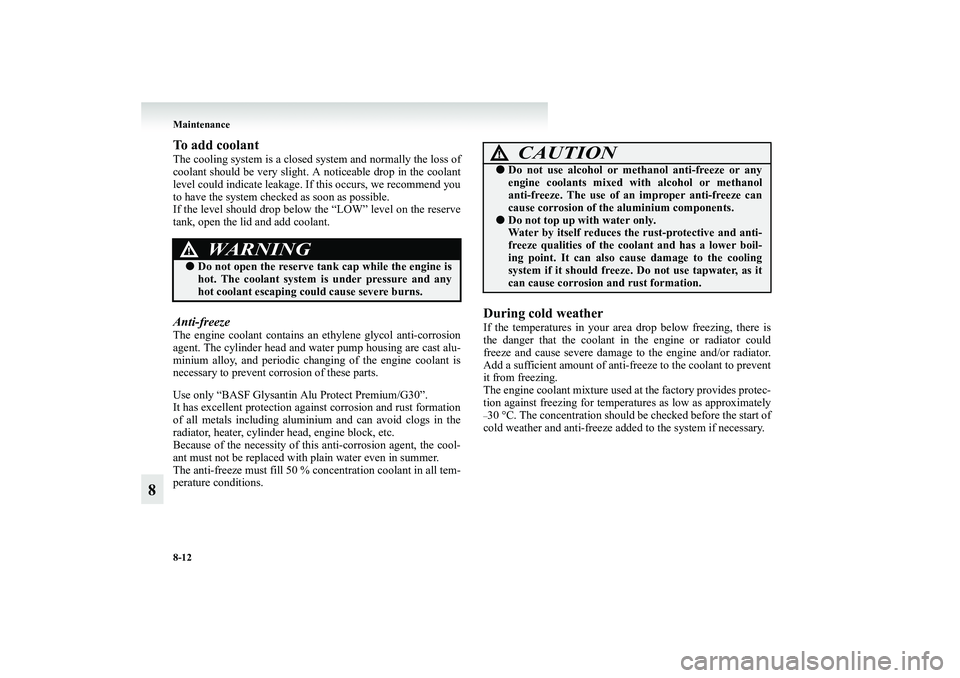oil temperature MITSUBISHI GRANDIS 2008 Owner's Manual (in English)
[x] Cancel search | Manufacturer: MITSUBISHI, Model Year: 2008, Model line: GRANDIS, Model: MITSUBISHI GRANDIS 2008Pages: 458, PDF Size: 18.52 MB
Page 193 of 458

Starting and driving
4-21
4
NOTE●If the engine is cold, the diesel preheat indication lamp is
on for a longer time.
●When the engine has not been started within about 5 sec-
onds after the diesel preheat indication lamp went out,
return the ignition key to the “LOCK” position. Then, turn
the key to the “ON” position to preheat the engine again.
●When the engine is warm, the diesel preheat indication
lamp does not come on even if the ignition key is placed
in the “ON” position.
Start the engine by turning the ignition key right to the
“START” position.
7. Turn the ignition key to the “START” position without
depressing the accelerator pedal, and release it when the
engine starts.NOTE●A ticking noise may be heard after starting the engine.
This is not an abnormal condition. The noise will disap-
pear after a short time of engine running.
If the ticking noise continues after the engine is warmed
up, we recommend you to have your vehicle checked.
Diesel particulate filter (DPF)
*
E00619800069
The diesel particulate filter (DPF) is a device that captures
most of the particulate matter (PM) in the exhaust emissions of
the diesel engine. The DPF automatically burns away trapped
PM during vehicle operation. Under certain driving conditions,
however, the DPF is not able to burn away all of the trapped
PM and, as a result, an excessive amount of PM accumulates
inside.NOTE●To minimize the likelihood of excessive accumulation of
PM, try to avoid driving for long periods at low speeds
and repeatedly driving short distances.
WARNING
!●The DPF reaches very high temperatures. Do not
park your vehicle in areas where combustible mate-
rials such as dry grass or leaves can come in contact
with the hot exhaust system since fire could occur.
CAUTION
!●Do not use any type of fuel or engine oil that is not
specified for your vehicle. Also, do not use any mois-
ture-removing agent or other fuel additive. Such
substances could have a detrimental effect on the
DPF.
Refer to “Fuel selection” on page 2 and “Engine oil”
on page 8-7.
BK-XP08E1ENUK.en-uk.book Page 21 Monday, August 13, 2007 2:20 PM
Page 352 of 458

7-4 Vehicle care
7
●Dirty genuine leather seat may mildew. Be very careful
about oil stains and remove them quickly.
●The genuine leather surface may harden and shrink if it is
exposed to direct rays of the sun for long hours. When
your vehicle is parked, place it in the shade as much as
possible.
●When the temperature of the vehicle interior rises in sum-
mer, vinyl products left on the genuine leather seat may
deteriorate and stick to the seat.
Cleaning the exterior of your vehicle
E00900700182
If the following is left on your vehicle, it may cause corrosion,
discolouration and stains, wash the vehicle as soon as possible.
●Seawater, anti-freeze for road use.
●Soot and dust, iron powder from factories, chemical sub-
stance (acids, alkalis, coal-tar, etc.).
●Droppings from birds, carcasses of insects, tree sap, etc.Wa s h i n g
E00900901123
Chemicals contained in the dirt and dust picked up from the
road surface can damage the paint coat and body of your vehi-
cle if left in prolonged contact.
Frequent washing and waxing is the best way to protect your
vehicle from this damage. This will also be effective in protect-
ing it from environmental elements such as rain, snow, salt air,
etc.
Do not wash the vehicle in direct sunlight. Park the vehicle in
the shade and spray it with water to remove dust. Next, using
an ample amount of clean water and a car washing brush or
sponge, wash the vehicle from top to bottom.
Use a mild car washing soap if necessary. Rinse thoroughly
and wipe dry with a soft cloth. After washing the vehicle, care-
fully clean the joints and flanges of the doors, bonnet, etc.,
where dirt is likely to remain.
CAUTION
!●When washing the under side of your vehicle or
wheel, be careful not to injure your hands.
BK-XP08E1ENUK.en-uk.book Page 4 Monday, August 13, 2007 2:20 PM
Page 365 of 458

Maintenance
8-9
8
Selection of engine oilPetrol-powered vehicles
1. Select engine oil of the proper SAE viscosity number
according to the atmospheric temperature.
SAE 0W-30, 5W-30, and 5W-40 engine oils can only be
used if they meet ACEA A3/B3, A3/B4 or A5/B5 and API
SG (or higher) specifications.
2. Use engine oil conforming to the following classification:
• API classification: “For service SG” or higher
• ILSAC certificated oil
• ACEA classification:
“For service A1/B1, A3/B3, A3/B4 or A5/B5”
NOTE●Use of additives is not recommended since they may
reduce the effectiveness of additives already included in
the engine oil. It may result in failure of the mechanical
assembly.
Diesel-powered vehicles
Use engine oil conforming to the following classification:
• Vehicles with DPF= “VW 50700”
• Vehicles without DPF= “VW 50501/50601/50700”NOTE●Use of additives is not recommended since they may
reduce the effectiveness of additives already included in
the engine oil. It may result in failure of the mechanical
assembly.
BK-XP08E1ENUK.en-uk.book Page 9 Monday, August 13, 2007 2:20 PM
Page 367 of 458

Maintenance
8-11
8
Because of the necessity of this anti-corrosion agent, the cool-
ant must not be replaced with plain water even in summer. The
required concentration of anti-freeze differs depending on the
expected ambient temperature.
Diesel-powered vehiclesThe coolant level in this tank should be kept between the
“LOW” and “FULL” marks when measured while the engine is
cold.
Ambient temperature
(minimum) °C
–15
–20
–25
–30
–35
–50
Anti-freeze
concentration %30 35 40 45 50 60CAUTION
!●Do not use alcohol or methanol anti-freeze or any
engine coolants mixed with alcohol or methanol
anti-freeze. The use of an improper anti-freeze can
cause corrosion of the aluminium components.●For effective anti-corrosion and anti-freeze per-
formance, keep the anti-freeze concentration within
the range of 30 to 60 %.
Concentrations exceeding 60 % will result in a
reduction of both the anti-freeze and cooling per-
formance thus adversely affecting the engine.●Do not top up with water only.
Water by itself reduces the rust-protective and anti-
freeze qualities of the coolant and has a lower boil-
ing point. It can also cause damage to the cooling
system if it should freeze. Do not use tapwater, as it
can cause corrosion and rust formation.
FULL
LOW
BK-XP08E1ENUK.en-uk.book Page 11 Monday, August 13, 2007 2:20 PM
Page 368 of 458

8-12 Maintenance
8
To add coolantThe cooling system is a closed system and normally the loss of
coolant should be very slight. A noticeable drop in the coolant
level could indicate leakage. If this occurs, we recommend you
to have the system checked as soon as possible.
If the level should drop below the “LOW” level on the reserve
tank, open the lid and add coolant.Anti-freezeThe engine coolant contains an ethylene glycol anti-corrosion
agent. The cylinder head and water pump housing are cast alu-
minium alloy, and periodic changing of the engine coolant is
necessary to prevent corrosion of these parts.
Use only “BASF Glysantin Alu Protect Premium/G30”.
It has excellent protection against corrosion and rust formation
of all metals including aluminium and can avoid clogs in the
radiator, heater, cylinder head, engine block, etc.
Because of the necessity of this anti-corrosion agent, the cool-
ant must not be replaced with plain water even in summer.
The anti-freeze must fill 50 % concentration coolant in all tem-
perature conditions.
During cold weatherIf the temperatures in your area drop below freezing, there is
the danger that the coolant in the engine or radiator could
freeze and cause severe damage to the engine and/or radiator.
Add a sufficient amount of anti-freeze to the coolant to prevent
it from freezing.
The engine coolant mixture used at the factory provides protec-
tion against freezing for temperatures as low as approximately–30 °C. The concentration should be checked before the start of
cold weather and anti-freeze added to the system if necessary.
WARNING
!●Do not open the reserve tank cap while the engine is
hot. The coolant system is under pressure and any
hot coolant escaping could cause severe burns.
CAUTION
!●Do not use alcohol or methanol anti-freeze or any
engine coolants mixed with alcohol or methanol
anti-freeze. The use of an improper anti-freeze can
cause corrosion of the aluminium components.●Do not top up with water only.
Water by itself reduces the rust-protective and anti-
freeze qualities of the coolant and has a lower boil-
ing point. It can also cause damage to the cooling
system if it should freeze. Do not use tapwater, as it
can cause corrosion and rust formation.
BK-XP08E1ENUK.en-uk.book Page 12 Monday, August 13, 2007 2:20 PM
Page 442 of 458

Alphabetical index
2Charge warning lamp 3-13
Chassis number 9-2
Check engine warning lamp 3-11, 3-12
Child restraint 2-40
Child-protection rear doors 1-10
Cigarette lighter 5-55
Cleaning
Exterior of your vehicle 7-4
Interior of your vehicle 7-3
Plastic, vinyl leather, etc 7-3
Clutch
Fluid 8-14, 9-16
Pedal free play 8-27
Coat hooks 5-77
Combination headlamps and dipper switch 3-32
Compact spare wheel 6-16
Coolant (engine) 8-10, 9-16
Corner sensor system 4-51
Cup holder 5-68
D
Daytime dipper button 3-7
Demister (rear window) 3-45
Diesel particulate filter (DPF) 4-21
Diesel preheat indication lamp 3-9
Dimensions 9-5
Dipper (High/Low beam change) 3-34
Door lamps 5-62
Bulb capacity 8-45Replacement 8-59
Doors
Central door locks 1-9
Child-protection 1-10
Lock and unlock 1-7
Driving, alcohol and drugs 4-3
E
Economical driving 4-2
Electric window control 1-16
Electrical system 9-11
Electronic immobilizer (Anti-theft starting system) 1-3
Emergency starting 6-2
Engine
Coolant 8-10, 9-16
MIVEC 4-20
Number 9-4
Oil 8-7
Oil and oil filter 9-16
Overheating 6-7
Specifications 9-9
Used engine oils safety instructions and disposal
information 7
Water temperature gauge 3-6
Engine specifications 9-9
Error codes 5-47
Exterior and interior lamp operation 8-31
BK-XP08E1ENUK.en-uk.book Page 2 Monday, August 13, 2007 2:20 PM
Page 447 of 458

Alphabetical index
7
Storage 6-10
Towing 6-28
Traction control function 4-41
TCL switch 4-42
Traction control system (TCL)
Indication lamp 4-43
Trailer towing 4-60
Transmission
Automatic transmission 4-26
Fluid 8-13, 9-16
Manual transmission 4-23
Oil 9-16
Specifications 9-10
Tripmeter 3-4
Turn-signal indication lamps 3-9
Turn/Lane-change signals 3-37
Tyres 8-21
How to change a tyre 6-20
Inflation pressures 8-21
Rotation 8-24
Size (tyre and wheel) 9-12
Snow tyres 8-25
Tyre chains 8-26
Wheel condition 8-23
U
Used engine oils safety instructions and disposal information 7
V
Vanity mirror 5-53
Vanity mirror lamps
Bulb capacity 8-45
Replacement 8-61
Vehicle care precautions 7-2
Vehicle dimensions 9-5
Vehicle identification number plate 9-3
Vehicle information code plate 9-3
Vehicle labeling 9-2
Vehicle performance 9-7
Vehicle weight 9-8
Ventilators 5-2
W
Warning lamps 3-10
Warning triangle retaining bands 5-78
Washer
Fluid 8-14, 9-16
Switch 3-41, 3-43
Washing 7-4
Water temperature gauge 3-6
Waxing 7-6
Weatherstripping 8-32
Weight 9-8
Wheel
Covers 6-26
Specification 9-12
BK-XP08E1ENUK.en-uk.book Page 7 Monday, August 13, 2007 2:20 PM